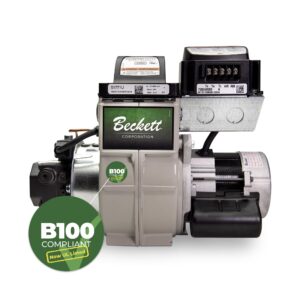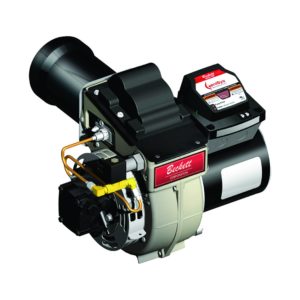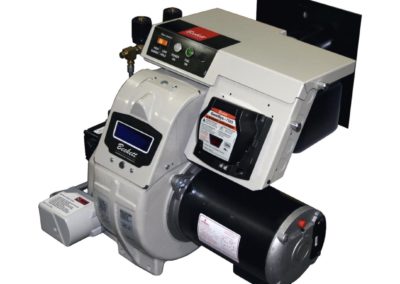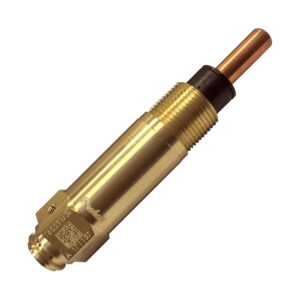PART I
Beckett’s Optional Electrode Settings
For many years our electrode settings have remained unchanged. However, in recent years we have found that an alternate electrode setting works very well in certain applications. This change amounts to lowering the electrode tips downward from the standard 7/16″ to 5/16″ above the nozzle centerline. Some installations are very susceptible to cold oil, cold air or high oil viscosity. The electrodes place the high voltage arc where it can more effectively ignite the larger droplets produced by colder or higher viscosity fuel oils. The following diagrams show both specifications for your comparison:
[Image Not Found]
These new dimensions can be used on all Series AF, AFG, SR, SM and SF burners.
NOTE: The standard electrode settings may continue to be specified by some of the appliance manufacturers. Always follow the O.E.M.’s specifications first and contact them prior to making any changes to the specifications for their approval.
The “T” Gauge in Transition
The “T” gauge is a Beckett tool which enables service technicians to check and/or set the nozzle, electrode or head position, along with other dimensional requirements for a Beckett burner.
Over the last ten years, a number of changes and additions have come about in the Beckett product line. A few of these have required us to either modify existing T gauges or create additional gauges. The T-430 was introduced with the Model AFII burners.
In early 1996 we recognized the importance of standardizing to one single gauge. This standardization process had to come about in several steps. The first three illustrations below show the gauges we have used, however, the T-500 design combines the functions of all of these gauges.
PART II
Beckett’s Reduced I.D. Nozzle Line Assembly
 In the early part of 1995, we began to phase in our new design nozzle line assembly. The new one-piece, reduced inside diameter construction, eliminates the need for the “filler rod”. The nozzle lines installed into the marketplace between 1986-1995 will have the rod installed. To determine which one, you have to look into the brass nozzle adapter and see whether there is a vent plug installed. If so, this is the earlier generation. The new nozzle line will have a thicker wall and smaller inside diameter, but no vent plug.
In the early part of 1995, we began to phase in our new design nozzle line assembly. The new one-piece, reduced inside diameter construction, eliminates the need for the “filler rod”. The nozzle lines installed into the marketplace between 1986-1995 will have the rod installed. To determine which one, you have to look into the brass nozzle adapter and see whether there is a vent plug installed. If so, this is the earlier generation. The new nozzle line will have a thicker wall and smaller inside diameter, but no vent plug.
Advantages Of One-Piece Unit
The full-length, reduced inside diameter (approximately .180″) lessens air volume. The one-piece, unitized construction eliminates the need for a vent plug and filler rod. This small bore purges air and gas bubbles as effectively as the previous three-piece nozzle line. Additionally, if post cycle heat migrates toward the nozzle line assembly, there will be less volume of “in line oil” to react upon. This thick-walled, reduced-diameter tubing has the same outside diameter as the standard three-piece nozzle line, so all components are interchangeable.
Did You Know?
 The nozzle line length is matched to the length of air tube on a specific burner. Let’s say your A.T.C. number (air tube combination) is AF72XN. The 72 is the usable length of the air tube (A dimension see back page) and represents 7 and 2/8 (1/4) inches. Measure dimension “A” and give it to your Beckett Distributor who can provide the correct length N.L.E.A. What if you don’t have this information handy but you do have the N.L.E.A. in your hands at your shop? Measure what we refer to as the “Q” dimension (see back page) and provide this information to your distributor.
The nozzle line length is matched to the length of air tube on a specific burner. Let’s say your A.T.C. number (air tube combination) is AF72XN. The 72 is the usable length of the air tube (A dimension see back page) and represents 7 and 2/8 (1/4) inches. Measure dimension “A” and give it to your Beckett Distributor who can provide the correct length N.L.E.A. What if you don’t have this information handy but you do have the N.L.E.A. in your hands at your shop? Measure what we refer to as the “Q” dimension (see back page) and provide this information to your distributor.
The Start Helper Nozzle Line Heater
 In 1996 R.W. Beckett Corp. officially introduced our nozzle line heater to the marketplace. This device will dramatically improve the light-off and run characteristics of your burners when you are experiencing a high oil viscosity condition. Oil viscosity can be simply defined as the measure of the oil’s resistance to flow. In other words, how thick it is. When oil gets cold, the viscosity goes up. High viscosity causes the flow rate through the nozzle to rise with considerably larger droplets. This makes the fuel more difficult to atomize, vaporize and ignite, and reduces the oil’s ability to burn clean. Cold temperature effects on heating oil viscosity is neutralized by the START HELPER, which preheats the oil in the burner nozzle line prior to start-up.
In 1996 R.W. Beckett Corp. officially introduced our nozzle line heater to the marketplace. This device will dramatically improve the light-off and run characteristics of your burners when you are experiencing a high oil viscosity condition. Oil viscosity can be simply defined as the measure of the oil’s resistance to flow. In other words, how thick it is. When oil gets cold, the viscosity goes up. High viscosity causes the flow rate through the nozzle to rise with considerably larger droplets. This makes the fuel more difficult to atomize, vaporize and ignite, and reduces the oil’s ability to burn clean. Cold temperature effects on heating oil viscosity is neutralized by the START HELPER, which preheats the oil in the burner nozzle line prior to start-up.
Inside the START HELPER is a solid-state, self-regulating heating element that maintains the temperature in the nozzle line. As the oil temperature drops, the heat output from the element increases to compensate. The Beckett START HELPER simply clamps around the nozzle line and is continuously energized to provide the help needed at the beginning of the start cycle by maintaining the oil temperatures at 130°-140°F during standby. Research confirms the fact that heating the oil in the nozzle can improve the ignition and flame quality during cold start-up. After the flame has been present for several minutes, the radiant heat on the nozzle and the friction heat from the fuel unit gearset help maintain increased oil temperatures. Therefore, the greatest benefit is realized during and just before start-up.































